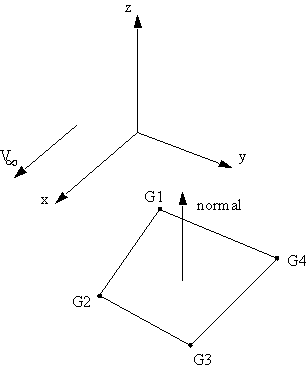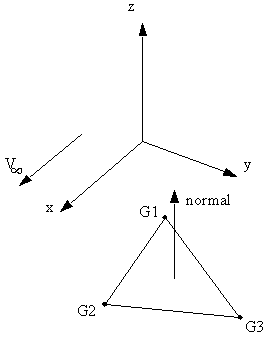
1 | 2 | 3 | 4 | 5 | 6 | 7 | 8 |
# |
1 | 2 | 3 | 4 | 5 | 6 | 7 | 8 |
SGROUP | SNAME |
SGROUP | lann_1 |
Field | Contents |
SNAME | Supergroup name. The length of the name is limited to 8 characters. Please do not use any blanks or hyphens in the name, use underscores instead. |
1 | 2 | 3 | 4 | 5 | 6 | 7 | 8 |
AGROUP | AGID | ANAME |
AGROUP | 47 | Wing_Top |
Field | Contents |
AGID | Aerodynamic Group ID |
ANAME | Name of the of the aerodynamic group. The group name is limited to 31 characters. Please do not use any blanks or hyphens in the name, use underscores instead. These groups are very useful to separate the aerodynamic model into functional components. It is important to split the model into groups to use the splining later on. It is strongly recommended that you split the model into parts like: Left_Wing_Top, Left_Wing_bot, Fuselage_Left, Fuselage_Right and so on. MSC Patran groups will be created automatically from these groups |
1 | 2 | 3 | 4 | 5 | 6 | 7 | 8 |
ADOF | ADOFS |
ADOF | 123 |
Field | Contents |
ADOFS | The list of degrees of freedom the aerodynamic grids possess. Note that only 125 is currently supported. Nonetheless, this entry is required. |
1 | 2 | 3 | 4 | 5 | 6 | 7 | 8 |
ACORD | ACID | XOR | YOR | ZOR | XZA | YZA | ZZA |
XXZ | YXZ | ZXZ |
ACORD | 1 | 0.0 | 0.0 | 0.0 | 0.0 | 0.0 | 1.0 |
1.0 | 0.0 | 0.0 |
Field | Contents |
ACID | Aero coordinate frame ID |
XOR | X-location of the origin |
YOR | Y-location of the origin |
ZOR | Z-location of the origin |
XZA | X-location of a point on the z-axis |
YZA | Y-location of a point on the z-axis |
ZZA | Z-location of a point on the z-axis |
XXZ | X-location of a point in the xz plane |
YXZ | Y-location of a point in the xz plane |
ZXZ | Z-location of a point in the xz plane |
Note: | Despite being a free field, this entry must be broken into two records as shown. |
1 | 2 | 3 | 4 | 5 | 6 | 7 | 8 |
AECORD | ACID |
AECORD | 1 |
Field | Contents |
ACID | Aero coordinate frame ID which will be used as aerodynamic reference frame. |
1 | 2 | 3 | 4 | 5 | 6 | 7 | 8 |
AGRID | GID | X | Y | Z | ACID |
AGRID | 781 | 10.456 | 27.678 | 1.938 | 1 |
Field | Contents |
GID | The ID of the aerodynamic grid point |
X | X-location of the grid point |
Y | Y-location of the grid point |
Z | Z-location of the grid point |
ACID | Aero coordinate frame ID which is the reference for the grid location. If the ID is 0 or blank the global (MSC Patran) or basic (MSC Nastran) coordinate system will be used for reference. |
1 | 2 | 3 | 4 | 5 | 6 | 7 | 8 |
EIDSTART | SEID | OFFSET |
EIDSTART | 2000001 | 10000 |
Field | Contents |
SEID | Starting element ID. This value is of type integer. |
OFFSET | Offset to be used when updating the starting element ID. This value is of type integer. |
Note: | These data are used to override the equivalent values in the MSC.FlightLoads and Dynamics Options menu. |
1 | 2 | 3 | 4 | 5 | 6 | 7 | 8 |
AQUAD | APID | G1 | G2 | G3 | G4 | AGID |
AQUAD | 123 | 12 | 13 | 46 | 45 | 47 |
Field | Contents |
APID | Aerodynamic panel ID |
Gi | Aerodynamic grid point IDs of the connection points. Must be unique. |
AGID | Aerodynamic Group ID the panel belongs to. |

1 | 2 | 3 | 4 | 5 | 6 | 7 | 8 |
ATRIA | APID | G1 | G2 | G3 | AGID |
ATRIA | 123 | 12 | 13 | 46 | 1234 |
Field | Contents |
APID | Aerodynamic panel ID |
Gi | Aerodynamic grid point IDs of the connection points. Must be unique. |
AGID | Aerodynamic Group ID the panel belongs to. |
